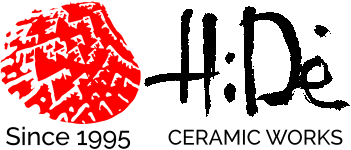Zen Light
HiDe´ Ebina’s Porcelights, like the rest of his ceramic artworks, are not complete until they have an everyday use and everyday user
by BEVERLY CRAMP
Ten years ago, HiDe´ Ebina was working in his poorly lit studio in an East Vancouver basement when a shaft of sunlight landed on one of his porcelain bowls.
“I saw how the light made the bowl translucent,” says Ebina. It was a break-through moment for the Japan-raised ceramic artist who chose to stay in Canada after a visit 14 years ago.
Ebina immediately began experimenting with lights of various shapes and sizes. He also continued to refine the particular clay mixture that produced his fine translucent ceramic lights. “I started with a lesser-quality clay. It has taken me a long time to evolve to the present form. I can’t tell you about the formula because it’s a secret,” he says with a conspiratorial smile.
Ebina calls these creations “Porcelights” and each is as individual as a finger print. Porcelights are made one at a time, thrown from Ebina’s potter wheel, altered and assembled by hand. Unlit, these ceramic pieces look like sculptures. They become transformed when the light is turned on and shed a golden glow.
Many of Ebina’s Porcelights have the flowing, rounded lines of organic forms such as spiny sea urchins or ridged bamboo poles. Others resemble sea shells or clam shells wired together. Still others have more stylized shapes such as cylinders or bells. Bits of metal or glass have been worked into some of the soft porcelain surfaces. But all are made utilizing traditional Japanese techniques in a refreshing new way.
“I have had traditional Japanese instructors but I consider myself self-taught,” says Ebina recalling how he had worked with old-fashioned wood-fired ceramic kilns while apprenticing in his homeland. “It would take four big trucks of wood and one month to chop the wood in order to get 10 days of firing in the kiln.”
Ebina now works with an electric powered kiln in Canada although the Japanese approach to ceramic creation has never left him. “I work with the concept that part of the creation is left to the process. I don’t want to control everything,” he says, holding up a thin, S-shaped sculpture. “This was straight when I put it in the kiln. What came out is the natural shape it took in the kiln.”
Ebina is influenced by Zen philosophy in that he is a follower of the Wabi Sabi way of being. Wabi-sabi doesn’t translate easily but it represents a world view and aesthetic centred on transience: nothing lasts forever, nothing is finished and nothing is perfect.
In Ebina’s words: “I play a part in a universe in which all things are connected. I become one with nature when I work with clay. When I make a plate it is only complete when the food is on it and people are using it. You need all three elements.”
Ebina also says that wheel throwing is improvisational. “You have to train yourself to a level that you don’t even think before you move, you do it by instinct. This way I react the way the clay wants. In this sense, I am a liaison between clay, the audience and the surroundings.”
This way of working is fun, says Ebina. “It is better to make something from the inside out. I don’t impose myself on the piece I’m creating. Rather I play with it and the shape expands from there.”
Ebina also enjoys creating things that have a practical bent. “It can be fine art but I also like the final piece to have some functional use. I want my pieces to become part of a daily life rather than hang on a wall.”
A number of Vancouver restaurants use Ebina’s unique Porcelights, including Kingyo on Denman Street, two Zakkushi restaurants and a third one soon to be opened on Main Street. He sells his ceramic works online (see hideart.com) to many customers in Toronto and other countries such as the United States, Singapore and Japan. His work is also on display at Numen Gallery in Yaletown.
Numen will be showing a special exhibition until June 1 entitled Merge that is a combination of glass and ceramic works by Ebina and two other Japanese Canadian artists.
An article from "Vancouver's life style magazine"2008
